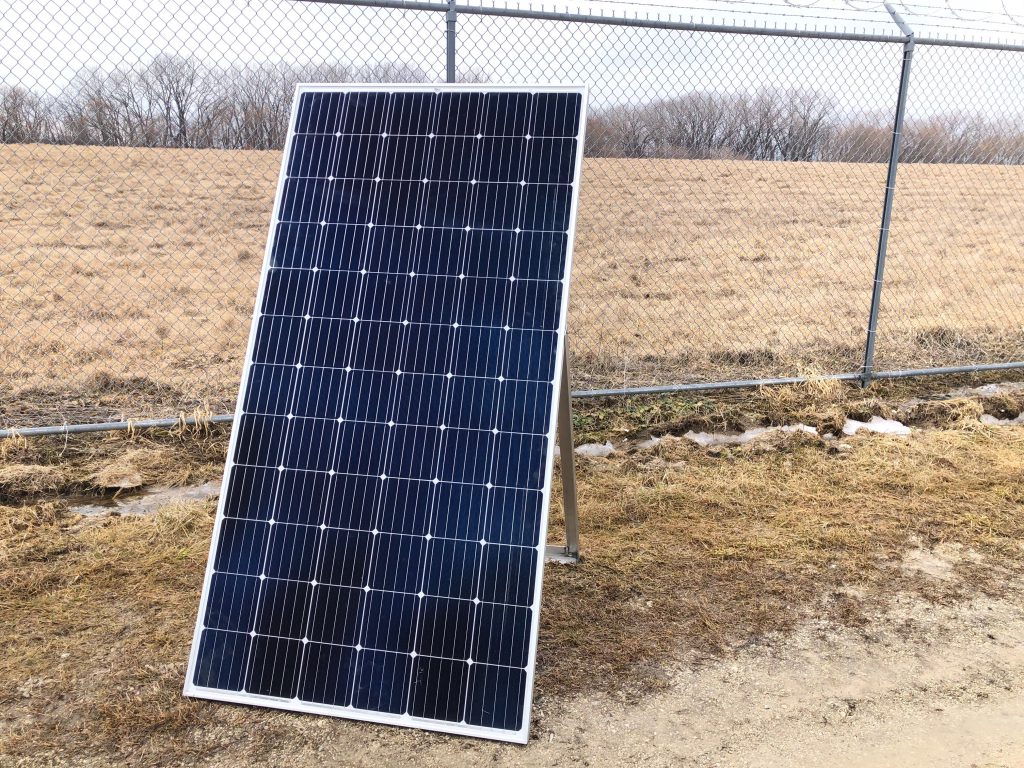New Solar Arrays Will Help Milwaukee Hit 25% Renewable Energy Goal
Arrays near airport help city meet 2025 goal, but alders want tougher rules for We Energies.
Two new, large solar arrays would allow the City of Milwaukee to reach its longstanding goal of generating 25% of its electricity from renewable sources by 2025.
We Energies would build “utility-scale” solar arrays on a former landfill near Milwaukee Mitchell International Airport and on 5 Mile Road in Caledonia, with the city being recognized on paper as the beneficiary of that grid-supplied electricity. The utility would also need to hire city residents to build a portion of the project.
“This is a big deal,” said Alderman Robert Bauman when the Public Works Committee reviewed the proposal Wednesday morning. The city instituted the 25 by 25 goal in 2009.
Environmental Collaboration Office (ECO) director Erick Shambarger said it represents a substantial scaling up of the city’s renewable energy efforts. The arrays would provide approximately 9.6 megawatts of energy, a substantial increase over the 2.25 megawatts currently produced by a smaller array on the landfill and 210 kilowatts atop three city libraries.
The city’s pathway to installing the panels isn’t as simple as buying the panels and feeding the energy into the grid. Energy regulations in Wisconsin protect utilities, causing the city to need to partner with We Energies on many of its renewable energy efforts. “We don’t have all the options other states have,” said Shambarger. The project, said the ECO director, represents a $30 million investment by the utility.
In 2023, We Energies secured Public Service Commission approval, with Milwaukee’s support, for its Renewable Pathways pilot program. It allows the utility to develop the two new arrays and recover the cost by charging a higher electrical rate to the city. The city would yield lease revenue, $800 per acre annually, from the landfill at 1600 E. College Ave., but would pay a premium of approximately a half-cent per kilowatt hour. The net result would have the city paying an additional $84,000 per year.
The cost is higher because Shambarger wanted the landfill site to be used and negotiated for city residents to be included in the project’s construction. “I’m not aware of anything in the utility space that required local labor until we asked for it,” said the ECO director. The proposal would require We Energies and its contractors to have 20% of the project work hours completed by unemployed or underemployed city residents as part of the Residents Preference Program (RPP) that is commonly applied to city-backed real estate development.
As was encountered in 2020, the site’s historic use as a landfill will reduce total potential solar power. The panel-supporting racks can’t be drilled into the ground, which avoids puncturing the clay cap the keeps the 1940s-through-1980s landfill sealed. As a consequence, the racks are held in place by ballast rocks and unable to pivot to follow the sun. The planned array in Caledonia, in northern Racine County, would yield more energy from its panels because the panels would receive more direct sunlight. “If it was up to them, they would not be building on this landfill. They would do more projects in Racine,” said Shambarger of We Energies. “I felt it was important to actually have stuff built in the city of Milwaukee where people can see it.”
Entering into the agreement also is intended to encourage We Energies to develop more renewable energy sources. “Currently, their fuel mix is about 6% renewables,” said Shambarger.
The increased cost of the latest project would be offset by the city’s revenue from the 2020 project, which is part of a different state-approved solar project with strict capacity limits. We Energies pays the city approximately $100,000 in annual rent for the earlier project. The amount could have been higher, but the city opted to forego a higher payment in exchange for accepting the credits, which legally declare Milwaukee the beneficiary of the generated electricity.
The city will similarly hold the certificates for the latest project, with the electricity itself being fed into the regional energy grid.
The federal Inflation Reduction Act cut the city’s expected annual price premium in half, said Shambarger. The act provides billions in clean energy incentives.
The city also negotiated for only a five-year lease agreement, down from a much longer framework the utility proposed in 2018 to the Public Service Commission. “We intentionally negotiated a shorter term so we weren’t locked in for 30 years on the pricing,” said Shambarger, citing the potential that Wisconsin’s regulatory landscape changes.
According to a 2020 report, the city spends approximately $4 million on electricity and natural gas for buildings, $3.5 million on street lights and $6 million on power for the Milwaukee Water Works. The 25 by 25 goal does not include the water utility’s energy consumption.
“I think this is incredible and your work is to be commended,” said Alderman Jonathan Brostoff. But not all of his colleagues agreed.
Labor Complications
The proposal is on hold pending a negotiation over an enforcement mechanism for the Milwaukee labor component.
“This is a good news, bad news story,” said Bauman, citing the labor component and renewable energy versus the increased cost. The alderman requested that Shambarger negotiate an enforcement provision for the labor component. “I don’t think [We Energies] will comply. They will thumb their noses and say ‘ha, fooled those guys.’ This has happened before,” said Bauman, a frequent critic of We Energies.
The alderman said he favored an agreement that used the landfill lease price to ensure compliance. Bauman said in real estate labor agreements the city uses subsidies provided by tax incremental financing districts as clawback protection. “We just want to make sure promises are kept,” he said.
“This will not be built if We Energies is left to their own devices,” said area Alderman Scott Spiker, a cosponsor with Bauman of the original proposal.
“We have to pay them to do the right thing,” said Bauman of the push for more renewable energy.
“That is, unfortunately, how capitalism works,” responded Spiker.
“But how democracy works is they could be converted to a public utility,” said Bauman.
“If the chair has a plan for accomplishing that at the state Legislature, I would love to hear it,” countered Spiker.
Brostoff and Alderwoman JoCasta Zamarripa joined Shambarger in requesting to keep the proposal moving forward. But Bauman, Lamont Westmoreland and Russell W. Stamper, II won a 3-2 vote to hold the proposal to allow for more negotiation. Stamper said he wasn’t in support of the increased cost. Spiker couldn’t vote because he isn’t on the committee.
The proposal is expected to return in three weeks at the next committee meeting.
Legislation Link - Urban Milwaukee members see direct links to legislation mentioned in this article. Join today
If you think stories like this are important, become a member of Urban Milwaukee and help support real, independent journalism. Plus you get some cool added benefits.
Related Legislation: File 231608
Political Contributions Tracker
Displaying political contributions between people mentioned in this story. Learn more.
























